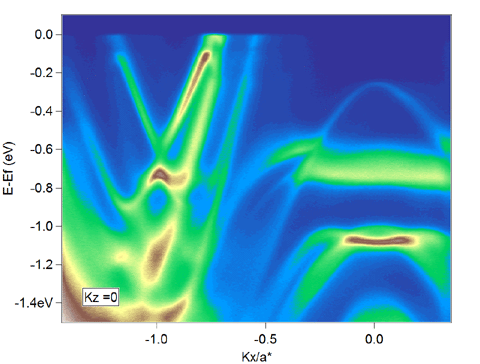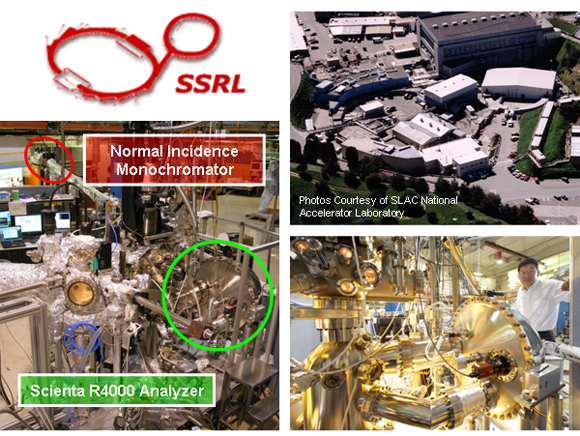Synchrotron ARPES

When exploring a novel material, a quick map of its electronic structure over the whole Brilliouin zone often provides informative guidance for further detailed experiments. Synchrotron ARPES, which produces photons with high flux and adjustable energy, is suitable for such experiments. The advantage of synchrotron ARPES over laser APRES becomes especially significant when we focus on three dimensional characteristics of the electronic structure. Over the last three decades, synchrotron-based ARPES has grown to become the main tool we deploy for the study of quantum materials.
Contents
Our Approach

The generation of synchrotron light is based on a single physical principle — accelerating electrons emit radiation. However, radiation produced by one electron moving along a sinusoidal path is too weak for our purpose. For that, we need many, many electrons moving together within a small volume, which is challenging due to strong Coulomb repulsion between electrons in confined volumes. In the Stanford Synchrotron Radiation Lightsource (SSRL), we overcome this challenge by accelerating electrons to a velocity of approximately 0.9999999885c (in which c is the speed of light), corresponding to an electron energy of 3 GeV. A ~1 m long strand of electrons is relativistically 'bunched' into ~0.1 mm in our laboratory reference frame, achieving compression without increasing Coulomb repulsion. These electron bunches orbit in a vacuum storage ring 234 meters in circumference. Currently, the storage ring houses ~280 electron bunches, each with a FWHM of ~15 picoseconds and separated by ~2 nanoseconds. Each bunch carries 0.36 mA for a total of 100 mA within the ring. Bunch and ring current can be increased further therforth.

To create light from the orbiting electrons, various insertion devices are installed to alter the trajectories of the bunches within the ring. Typically, we utilize a linearly polarized undulator, which arrays a series of permanent magnets with alternating poles in order to 'wiggle' electron bunches in a sinusoidal pattern. As an electron bunch traverses a period of the sine wave, light emitted adds coherently to the light from previous periods. At the end of the undulator, a bright beam of coherent light is produced and directed toward the beamline. Each electron bunch creates a bright pulse of light and the number of bunches with the small-time separation yields a quasi-continuous light source. The photon beam that directly comes out of the beamline is focused upon a 150 × 300 micron spot size on the sample, which improves the eventual spectral resolution of ARPES.
Beamline Facilities
Our group assists in the maintenance of three beamlines: SSRL beamline 5-4, SSRL beamline 5-2, and ALS beamline 10.0.1. Here are some of their specifications.

SSRL Beamline 5-4
The BL5-4 station is a normal incidence monochromator beamline optimized for high-resolution ARPES in the photon energy range of 7 – 40 eV with polarization control (circular polarization: 7 – 40 eV, linear polarization: 16 – 40 eV). The dedicated experimental end station is equipped with a SCIENTA R4000 electron spectrometer. This system is capable of performing ARPES experiments with a total energy resolution of a few meV and an angular resolution of 0.3°. It is also equipped with a low-temperature sample manipulator with two rotational degrees of freedom, which can be cooled down to 5 K.
SSRL Beamline 5-2
The BL5-2 station is a plane grating monochromator beam line optimized for high-resolution ARPES, in the photon energy range of 25 – 200 eV with full polarization control. The dedicated experimental end station is equipped with a SCIENTA DA30 electron spectrometer. This system is capable of performing ARPES experiments with a total energy resolution of a few meV and an angular resolution of ~0.1°. It is also equipped with a low-temperature sample manipulator with three rotational degrees of freedom, which can be cooled down to less than 10 K. Beamline 5-2 features an interconnected molecular beam epitaxy (MBE) and ARPES system which facilitates in-situ sample growth and characterization.

ALS Beamline 10.0.1

Beamline 10.0.1 utilizes photons delivered by the U10 undulator, a 4.5 m long undulator with a 10 cm period magnet array. The beamline is equipped with a set of three spherical grating monochromators (SGMs). By changing the angles of the SGM with respect to the incident beam, one can select photons of energy range 17 – 340 eV with a resolution better than energy divided by 10,000. Typically, ARPES measurements are made with 30 – 60 eV photons, and the resolution contribution from the beamline is less than 3 – 6 meV. The energies and momenta of photoelectrons generated by the incident beam are analyzed by the Scienta R4000 hemispherical analyzer. This High Energy Resolution Spectrometer (HERS) system is also equipped with standard surface-science preparation and characterization tools, such as molecular beam epitaxy, ion sputtering gun, e-beam heater, low-energy electron diffraction (LEED), and an x-ray tube. The most unique aspect of the HERS system is that the hemispherical analyzer itself can rotate around the sample. This confers important advantages over conventional ARPES systems, in which the sample is rotated to probe different directions in k-space. Firstly, the whole geometry of the sample, polarization of the beam, and the beamspot on the sample are fixed throughout the measurement. Additionally, by changing the sample normal along with the analyzer angle with respect to beam polarization, one can control vertical and horizontal components of beam polarization on the sample surface.
Our Results
Incoherent peak sharply bounded by a critical doping in Bi2212

In the cuprates, strong on-site Coulomb repulsion produces a normal state that deviates strongly from Fermi liquid behavior over a wide region of the phase diagram around optimal doping. This phase is known as a strange metal. People have long believed that the strange metal phase is associated with a quantum critical point, which casts a V- (or fan-) shaped effect on the overdoped side of the cuprate phase diagram. However, Su-Di Chen, Makoto Hashimoto et al. carried out a systematic ARPES study near critical doping (pc ~ 0.19) and proposed a new approach to understand the strange metal, in which the incoherent strange metal phase is sharply bounded by a critical doping [1]. They observed that photoemission spectra evolved differently just below and just above critical doping. This behavior indicated that the incoherent strange metal is a distinct state, and a prerequisite for the pseudogap.
Selected Publications
[1] Su-Di Chen, Makoto Hashimoto, et al., Science 366, 1099-1102 (2019)